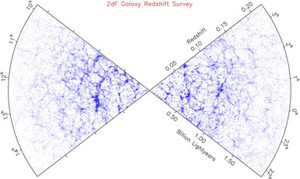Galactic Sheets
With lengths and breadths of hundreds of millions of light years but thicknesses of only ~20 million light years, galactic sheets (also known as great walls) are some of the largest known structures in the Universe. They consist of huge aggregates of galaxies (groups and clusters as well as isolated galaxies), and give the Universe the ‘honey-comb’ appearance evident in the following figures.

The Australian led 2dF galaxy survey measured accurate distances to hundreds of thousands of galaxies. This image, which shows the spatial distribution of ~100,000 galaxies, reveals that large-scale structures and voids are clearly observable in the local Universe.
Credit: M. Colless (ANU) and the 2dF Galaxy Redshift Survey |

This model of large-scale structure in the local Universe (72 Mpc square) was created on the Swinburne supercomputer assuming a λCDM cosmology. Red regions indicate high concentrations of galaxies, with long filaments and superclusters (the bright knots at the intersections of the filaments) clearly visible. Sheets are also present, but not visible in this 2-dimensional representation. The dark blue regions indicate low concentrations of galaxies and outline the galactic voids resulting from this model.
Credit: Chris Power, Swinburne University |
Large-scale structures such as sheets and galactic filaments contain millions of galaxies and span significant fractions of the observable Universe. They are thought to form through the hierarchical clustering of galaxies around primordial density fluctuations (quantum mechanical fluctuations in the density of the Universe in the very first moments following the Big Bang), and are separated by large galactic voids.
If hierarchical clustering is indeed responsible for the formation of galactic sheets, voids and filaments, it is interesting to consider that while these enormous structures reveal a great deal about the present day Universe on the largest scales, they also tell us something about processes on the very smallest scales in the very early Universe.
Study Astronomy Online at Swinburne University
All material is © Swinburne University of Technology except where indicated.

